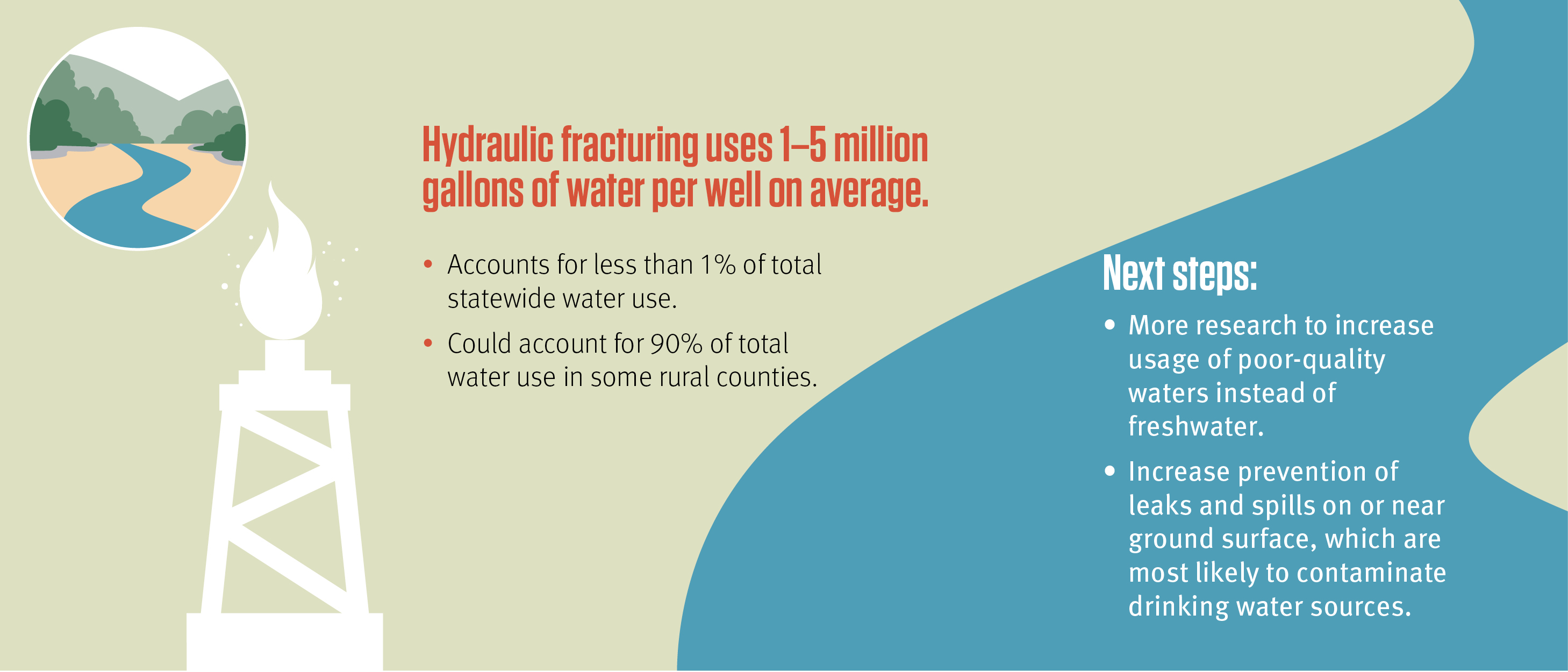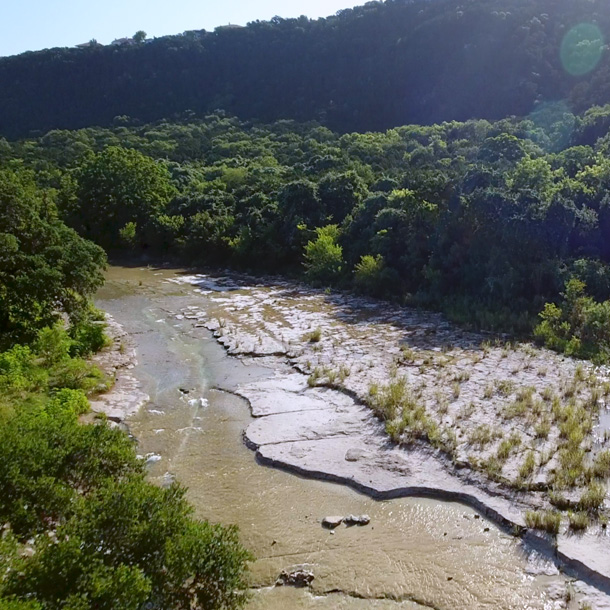Water Impacts
Some of the most significant public concerns surrounding the application of hydraulic fracturing operations regards possible effects on both the available supply of water and possible effects on water quality. Surface spills and leaks are also a potential concern for drinking water supplies.

- Hydraulic fracturing uses 1–5 million gallons of water per well on average.
- Water used for hydraulic fracturing activities accounts for less than 1% of total statewide water use, but it could account for the majority of total water use in some rural counties.
- More research is needed to increase usage of poor-quality waters instead of freshwater.
- Increase prevention of leaks and spills on or near ground surface, which are most likely to contaminate drinking water sources.
Frequently Asked Questions
What impacts does shale oil and gas development have on water resources?
Overall, shale development does not use that much water when compared to other areas of water use. In Texas, water used for hydraulic fracturing represents a small amount—less than 1% of the statewide total water use. However, there are areas throughout the state where water usage can be more significant and important.
Texas has the opportunity to use poor quality waters—such as highly salty, or brackish water or produced water from oil and gas operations—rather than freshwater for hydraulic fracturing. Non-potable brackish surface or ground waters are a substantial resource in West Texas. Another source of brackish water is the water co-produced with oil production, and, to a lesser extent, shale gas production. Since there is no reasonable chance these waters can ever be used for drinking or for agriculture, using them for hydraulic fracturing helps reduce the amount of freshwater used in this process.
Is there a risk for shale oil and gas production to contaminate our drinking water?
The most common pathways for contaminating drinking water sources and causing environmental damage are with surface spills and well casing leaks near the surface.
The depth and separation between oil-bearing and drinking water-bearing zones make contamination of potential drinking water unlikely. Contamination between these two zones has not been observed in Texas.
How can Texas better manage the leaks and spills that are associated with shale development?
There is an opportunity to do a better job of tracking spills and leaks to improve our response to these issues. Information on spills and leaks from oil and gas activities in Texas is less accessible and detailed than in some states, potentially limiting the ability to identify sources and root causes.
Can produced waters be used for drinking or agriculture?
Treating produced waters for use on farms isn’t really an option. The challenge is that water is relatively cheap, and the costs associated with managing, transporting, processing and treating produced waters for agricultural or drinking purposes are not economical.
Waters are also not necessarily produced in the same places where this water is needed for fracturing. The cost associated with transporting these waters for use is not economical.
What is brackish water? Produced water? Flowblack water?
Brackish water refers to water that is more saline than freshwater, but not as saline as seawater. Non-potable brackish surface and ground waters are one source of brackish waters; another source is the water produced from oil and gas production.
Produced waters are defined as any water that is produced from a well, including flowback (the return of water injected into a well) and formation waters (waters originally in the subsurface formation and being brought to the surface for the first time).

“Even though the overall amount of water used for hydraulic fracturing processes in Texas is low, there are areas within the state where the amount used is much more important and will be of more concern.”
~Danny Reible, NAE, Texas Tech University
Water Quantity and Quality Findings
- Water used in hydraulic fracturing processes in Texas represents a small fraction—less than 1 percent—of total water use statewide. In some regions and locales in Texas, however, water used in hydraulic fracturing represents a significantly larger proportion of local water sources.
- Use of brackish groundwater and produced water for hydraulic fracturing can reduce freshwater use. Increased use of these waters, however, can potentially increase impacts to land and water due to spills and leaks.
- The depth separation between oil-bearing zones and drinking water-bearing zones in Texas makes direct fracturing into drinking water zones unlikely, and it has not been observed in Texas.
- Surface spills and well casing leaks near the surface are the most likely pathways for oil and gas activities to lead to contamination of drinking water sources and environmental damage.
- Information on spills and leaks from oil and gas activities in Texas is less accessible and detailed than in some states, potentially limiting the ability to identify sources and root causes.
- In Texas, both economics and risk considerations dictate that much of the produced water will continue to be injected in deep wells or used as fracturing fluid to minimize impacts on other water sources.
Water Quantity and Quality Recommendations
Water Availability and Supply
- Research and testing to enable the use of brackish groundwater and produced waters for hydraulic fracturing should be encouraged.
- Recent Railroad Commission of Texas rules to encourage recycling should be tracked, and their effectiveness for promoting increased use of produced water should be evaluated.
- Aquifer investigations including pumping tests and chemical analyses should be used to better characterize the productivity and chemical composition of brackish groundwater, and variability of these properties, in oil and gas producing areas.
- Further research on the broad life-cycle risks related to water management decisions should be conducted. This research should recognize trade-offs among water use sectors and provide a basis for balancing increased use of poor-quality waters with freshwater use for new hydraulic fracturing activities.
Subsurface Contamination by Fracturing or Formation Fluid
- Direct migration of contaminants from targeted injection zones is highly unlikely to lead to contamination of potential drinking water aquifers. The collection and sharing of pressure data relevant to communication between water-bearing and producing strata—including non-commercial flow zones—or across wells could help identify and avoid potential concerns.
Spills of Flowback Water, Drilling Fluid and Formation Water at the Surface
- Statewide leak and spill reporting requirements for produced water should be considered. For all spilled substances, reporting requirements should be improved to aid identification of the primary sources of leaks and appropriate management responses.
- Texas regulators and industry should continue to develop and apply best management practices relative to well casing design and construction, and surface management of oil and gas operations, to reduce inadvertent release of fluids.
Wastewater Treatment and/or Disposal
- Research on techniques for cost-effectively treating produced water, particularly for uses that have minimal quality requirements, such as for hydraulic fracturing, should be continued.
- Additional research to evaluate potential negative impacts of any such uses also should be undertaken.

Danny Reible, NAE (Lead)
Texas Tech University

Denny Bullard
Texas Tech University

Michael Young
The University of Texas at Austin
For media inquiries about water quantity and quality impacts, please visit our Media Center page.

